Maria Lomeli
Stochastic activations
Sep 26, 2025Abstract:We introduce stochastic activations. This novel strategy randomly selects between several non-linear functions in the feed-forward layer of a large language model. In particular, we choose between SILU or RELU depending on a Bernoulli draw. This strategy circumvents the optimization problem associated with RELU, namely, the constant shape for negative inputs that prevents the gradient flow. We leverage this strategy in two ways: (1) We use stochastic activations during pre-training and fine-tune the model with RELU, which is used at inference time to provide sparse latent vectors. This reduces the inference FLOPs and translates into a significant speedup in the CPU. Interestingly, this leads to much better results than training from scratch with the RELU activation function. (2) We evaluate stochastic activations for generation. This strategy performs reasonably well: it is only slightly inferior to the best deterministic non-linearity, namely SILU combined with temperature scaling. This offers an alternative to existing strategies by providing a controlled way to increase the diversity of the generated text.
Inference-time sparse attention with asymmetric indexing
Feb 12, 2025Abstract:Self-attention in transformer models is an incremental associative memory that maps key vectors to value vectors. One way to speed up self-attention is to employ GPU-compliant vector search algorithms, yet the standard partitioning methods yield poor results in this context, because (1) keys and queries follow different distributions and (2) the effect of RoPE positional encoding. In this paper, we introduce SAAP (Self-Attention with Asymmetric Partitions), which overcomes these problems. It is an asymmetrical indexing technique that employs distinct partitions for keys and queries, thereby approximating self-attention with a data-adaptive sparsity pattern. It works on pretrained language models without finetuning, as it only requires to train (offline) a small query classifier. On a long context Llama 3.1-8b model, with sequences ranging from 100k to 500k tokens, our method typically reduces by a factor 20 the fraction of memory that needs to be looked-up, which translates to a time saving of 60\% when compared to FlashAttention-v2.
Evaluation data contamination in LLMs: how do we measure it and (when) does it matter?
Nov 06, 2024
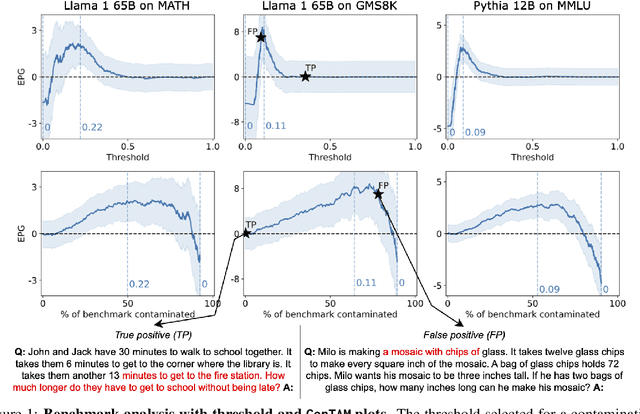
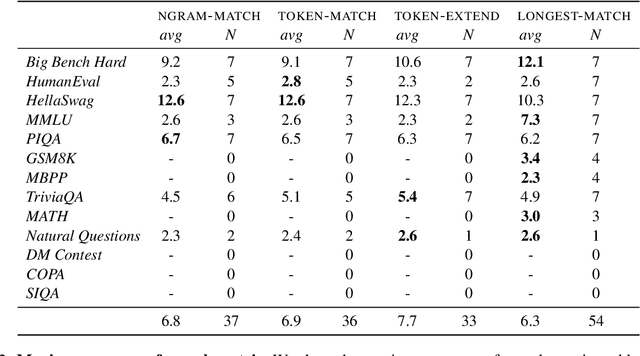
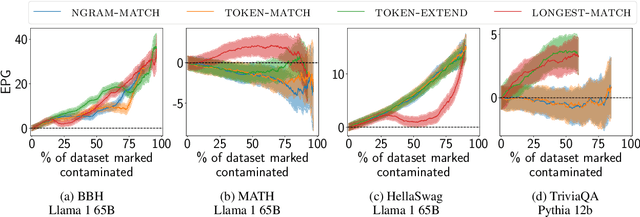
Abstract:Hampering the interpretation of benchmark scores, evaluation data contamination has become a growing concern in the evaluation of LLMs, and an active area of research studies its effects. While evaluation data contamination is easily understood intuitively, it is surprisingly difficult to define precisely which samples should be considered contaminated and, consequently, how it impacts benchmark scores. We propose that these questions should be addressed together and that contamination metrics can be assessed based on whether models benefit from the examples they mark contaminated. We propose a novel analysis method called ConTAM, and show with a large scale survey of existing and novel n-gram based contamination metrics across 13 benchmarks and 7 models from 2 different families that ConTAM can be used to better understand evaluation data contamination and its effects. We find that contamination may have a much larger effect than reported in recent LLM releases and benefits models differently at different scales. We also find that considering only the longest contaminated substring provides a better signal than considering a union of all contaminated substrings, and that doing model and benchmark specific threshold analysis greatly increases the specificity of the results. Lastly, we investigate the impact of hyperparameter choices, finding that, among other things, both using larger values of n and disregarding matches that are infrequent in the pre-training data lead to many false negatives. With ConTAM, we provide a method to empirically ground evaluation data contamination metrics in downstream effects. With our exploration, we shed light on how evaluation data contamination can impact LLMs and provide insight into the considerations important when doing contamination analysis. We end our paper by discussing these in more detail and providing concrete suggestions for future work.
Source2Synth: Synthetic Data Generation and Curation Grounded in Real Data Sources
Sep 12, 2024



Abstract:Large Language Models still struggle in challenging scenarios that leverage structured data, complex reasoning, or tool usage. In this paper, we propose Source2Synth: a new method that can be used for teaching LLMs new skills without relying on costly human annotations. Source2Synth takes as input a custom data source and produces synthetic data points with intermediate reasoning steps grounded in real-world sources. Source2Synth improves the dataset quality by discarding low-quality generations based on their answerability. We demonstrate the generality of this approach by applying it to two challenging domains: we test reasoning abilities in multi-hop question answering (MHQA), and tool usage in tabular question answering (TQA). Our method improves performance by 25.51% for TQA on WikiSQL and 22.57% for MHQA on HotPotQA compared to the fine-tuned baselines.
TOOLVERIFIER: Generalization to New Tools via Self-Verification
Feb 21, 2024



Abstract:Teaching language models to use tools is an important milestone towards building general assistants, but remains an open problem. While there has been significant progress on learning to use specific tools via fine-tuning, language models still struggle with learning how to robustly use new tools from only a few demonstrations. In this work we introduce a self-verification method which distinguishes between close candidates by self-asking contrastive questions during (1) tool selection; and (2) parameter generation. We construct synthetic, high-quality, self-generated data for this goal using Llama-2 70B, which we intend to release publicly. Extensive experiments on 4 tasks from the ToolBench benchmark, consisting of 17 unseen tools, demonstrate an average improvement of 22% over few-shot baselines, even in scenarios where the distinctions between candidate tools are finely nuanced.
The Faiss library
Jan 16, 2024


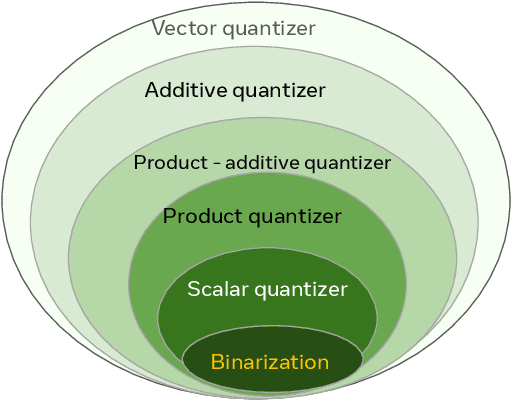
Abstract:Vector databases manage large collections of embedding vectors. As AI applications are growing rapidly, so are the number of embeddings that need to be stored and indexed. The Faiss library is dedicated to vector similarity search, a core functionality of vector databases. Faiss is a toolkit of indexing methods and related primitives used to search, cluster, compress and transform vectors. This paper first describes the tradeoff space of vector search, then the design principles of Faiss in terms of structure, approach to optimization and interfacing. We benchmark key features of the library and discuss a few selected applications to highlight its broad applicability.
In-Context Pretraining: Language Modeling Beyond Document Boundaries
Oct 20, 2023Abstract:Large language models (LMs) are currently trained to predict tokens given document prefixes, enabling them to directly perform long-form generation and prompting-style tasks which can be reduced to document completion. Existing pretraining pipelines train LMs by concatenating random sets of short documents to create input contexts but the prior documents provide no signal for predicting the next document. We instead present In-Context Pretraining, a new approach where language models are pretrained on a sequence of related documents, thereby explicitly encouraging them to read and reason across document boundaries. We can do In-Context Pretraining by simply changing the document ordering so that each context contains related documents, and directly applying existing pretraining pipelines. However, this document sorting problem is challenging. There are billions of documents and we would like the sort to maximize contextual similarity for every document without repeating any data. To do this, we introduce approximate algorithms for finding related documents with efficient nearest neighbor search and constructing coherent input contexts with a graph traversal algorithm. Our experiments show In-Context Pretraining offers a simple and scalable approach to significantly enhance LMs'performance: we see notable improvements in tasks that require more complex contextual reasoning, including in-context learning (+8%), reading comprehension (+15%), faithfulness to previous contexts (+16%), long-context reasoning (+5%), and retrieval augmentation (+9%).
RA-DIT: Retrieval-Augmented Dual Instruction Tuning
Oct 08, 2023
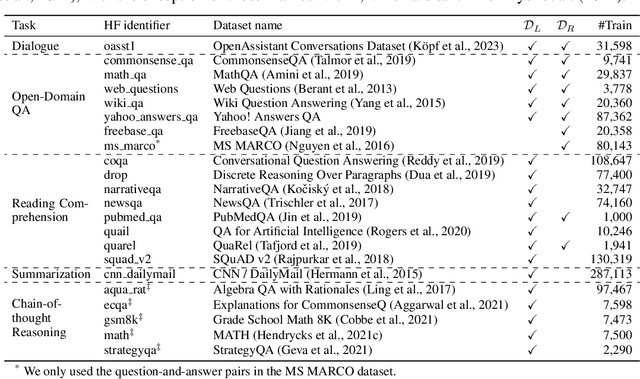
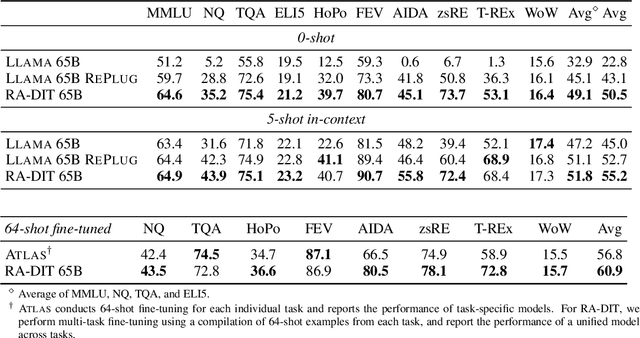
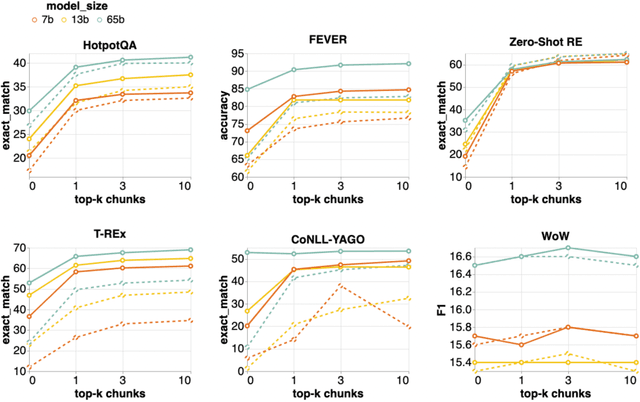
Abstract:Retrieval-augmented language models (RALMs) improve performance by accessing long-tail and up-to-date knowledge from external data stores, but are challenging to build. Existing approaches require either expensive retrieval-specific modifications to LM pre-training or use post-hoc integration of the data store that leads to suboptimal performance. We introduce Retrieval-Augmented Dual Instruction Tuning (RA-DIT), a lightweight fine-tuning methodology that provides a third option by retrofitting any LLM with retrieval capabilities. Our approach operates in two distinct fine-tuning steps: (1) one updates a pre-trained LM to better use retrieved information, while (2) the other updates the retriever to return more relevant results, as preferred by the LM. By fine-tuning over tasks that require both knowledge utilization and contextual awareness, we demonstrate that each stage yields significant performance improvements, and using both leads to additional gains. Our best model, RA-DIT 65B, achieves state-of-the-art performance across a range of knowledge-intensive zero- and few-shot learning benchmarks, significantly outperforming existing in-context RALM approaches by up to +8.9% in 0-shot setting and +1.4% in 5-shot setting on average.
Augmented Language Models: a Survey
Feb 15, 2023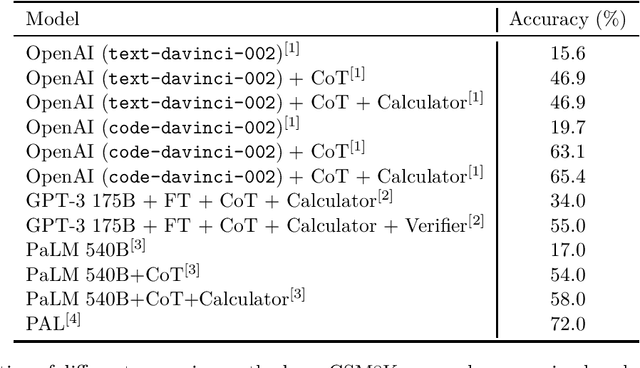

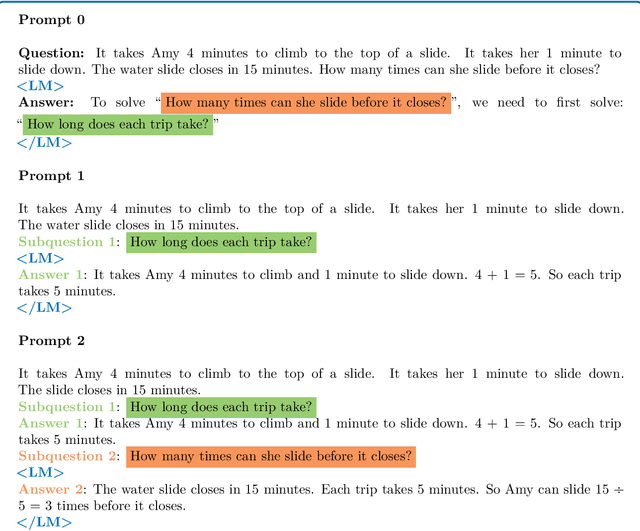

Abstract:This survey reviews works in which language models (LMs) are augmented with reasoning skills and the ability to use tools. The former is defined as decomposing a potentially complex task into simpler subtasks while the latter consists in calling external modules such as a code interpreter. LMs can leverage these augmentations separately or in combination via heuristics, or learn to do so from demonstrations. While adhering to a standard missing tokens prediction objective, such augmented LMs can use various, possibly non-parametric external modules to expand their context processing ability, thus departing from the pure language modeling paradigm. We therefore refer to them as Augmented Language Models (ALMs). The missing token objective allows ALMs to learn to reason, use tools, and even act, while still performing standard natural language tasks and even outperforming most regular LMs on several benchmarks. In this work, after reviewing current advance in ALMs, we conclude that this new research direction has the potential to address common limitations of traditional LMs such as interpretability, consistency, and scalability issues.
Toolformer: Language Models Can Teach Themselves to Use Tools
Feb 09, 2023



Abstract:Language models (LMs) exhibit remarkable abilities to solve new tasks from just a few examples or textual instructions, especially at scale. They also, paradoxically, struggle with basic functionality, such as arithmetic or factual lookup, where much simpler and smaller models excel. In this paper, we show that LMs can teach themselves to use external tools via simple APIs and achieve the best of both worlds. We introduce Toolformer, a model trained to decide which APIs to call, when to call them, what arguments to pass, and how to best incorporate the results into future token prediction. This is done in a self-supervised way, requiring nothing more than a handful of demonstrations for each API. We incorporate a range of tools, including a calculator, a Q\&A system, two different search engines, a translation system, and a calendar. Toolformer achieves substantially improved zero-shot performance across a variety of downstream tasks, often competitive with much larger models, without sacrificing its core language modeling abilities.
 Add to Chrome
Add to Chrome Add to Firefox
Add to Firefox Add to Edge
Add to Edge